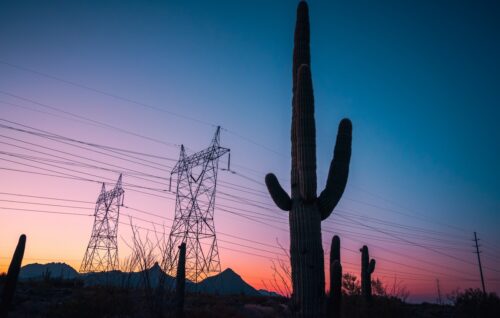Saguaro cactus and powerline silhouettes during before sunrise

Statement: As EPA Finalizes New Power Plant Rules, Clean, Reliable Solutions Abound
Washington, DC, April 25, 2024 – Today, the US Environmental Protection Agency (EPA) finalized new pollution reduction standards for coal plants and new gas-fired power plants.
In response, electric sector expert Mark Dyson with the non-partisan group RMI released the following statement:
“EPA’s new standards make the quick, no-regrets tools we have for grid expansion even more attractive than they already were. Electricity providers can plug in cheap clean energy resources at the sites of waning fossil fuel plants, upgrade power lines using the latest hardware and software, and improve the coordination of electric loads such as electric vehicles, battery storage systems, and rooftop solar panels. These solutions have already prevented bloated bills and blackouts in communities across the country, and they can help electricity providers come into compliance with these standards.”
For media inquiries please contact:
Leah Komos, leah.komos@rmi.org
More Information on Key Carbon-Free Reliability Solutions for the Electric Sector:
“Clean repowering” by leveraging existing interconnection rights
Connecting new clean energy resources at the sites of existing or retiring fossil plants offers a unique opportunity to expedite clean energy deployment and take advantage of federal tax credits and programs in the IRA. Where coal plants are retired or mothballed as a result of the EPA standards, “clean repowering” can allow new clean generation to come online quickly and provide a low-cost substitute, so the grid doesn’t miss a beat. RMI analysis highlights the regions that support these opportunities, which can unlock 250 gigawatts of clean energy that saves customers $12.7 billion annually.
Add more power now with grid enhancing technologies (GETs) and advanced conductoring
Technologies and upgrades that increase the capacity of existing transmission lines can help bring more clean energy online faster, reducing reliance on fossil resources to meet near-term load growth, while also delivering system-wide savings. Just 95 deployments of “grid-enhancing technologies,” or hardware and software solutions to increase grid capacity, could enable 6.6 gigawatts of new clean energy with $1B/year in production cost savings. Advanced conductoring, or replacing wires through existing transmission rights of way, can double the capacity of transmission lines at half the cost of building new ones.
Virtual power plants (VPPs)
As new electricity-powered devices such as electric vehicles, heat pumps, smart thermostats, and home batteries get connected to the grid, they can be aggregated and coordinated in ways that provide the same value to the grid as traditional power plants. These “virtual power plants” — which are already helping support the grid in Texas and California — could save US utility customers $10 billion per year and reduce peak electricity use by 20 percent by the end of this decade, significantly alleviating any pressure from growing electricity demand. And all without the need to wait years for investment in power lines and other traditional infrastructure.
About RMI
RMI, founded in 1982 as Rocky Mountain Institute, is an independent nonprofit that transforms global energy systems through market-driven solutions to align with a 1.5°C future and secure a clean, prosperous, zero-carbon future for all. We work in the world’s most critical geographies and engage businesses, policymakers, communities, and NGOs to identify and scale energy system interventions that will cut greenhouse gas emissions by at least 50 percent by 2030. RMI has offices in Basalt and Boulder, Colorado; New York City; Oakland, California; Washington, D.C.; Nigeria; and Beijing. Find more information at www.rmi.org and follow us on LinkedIn @RMI.